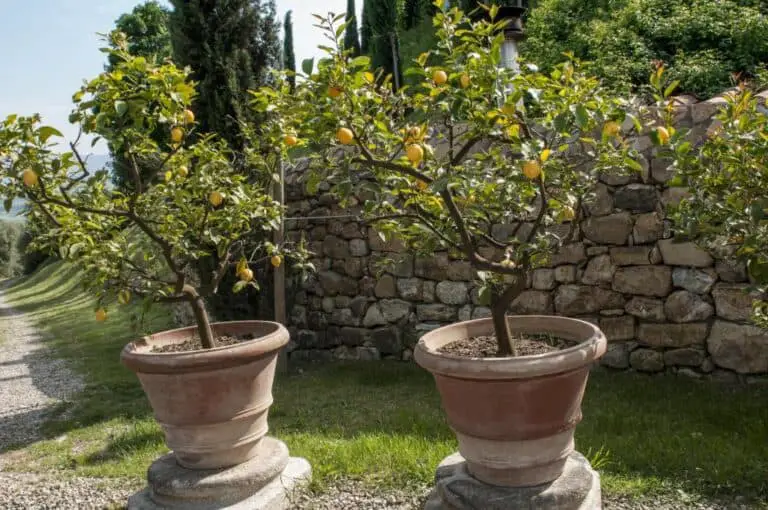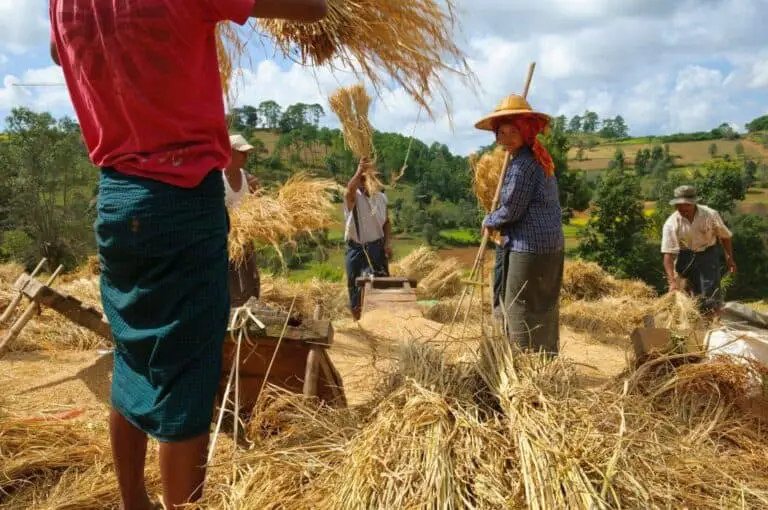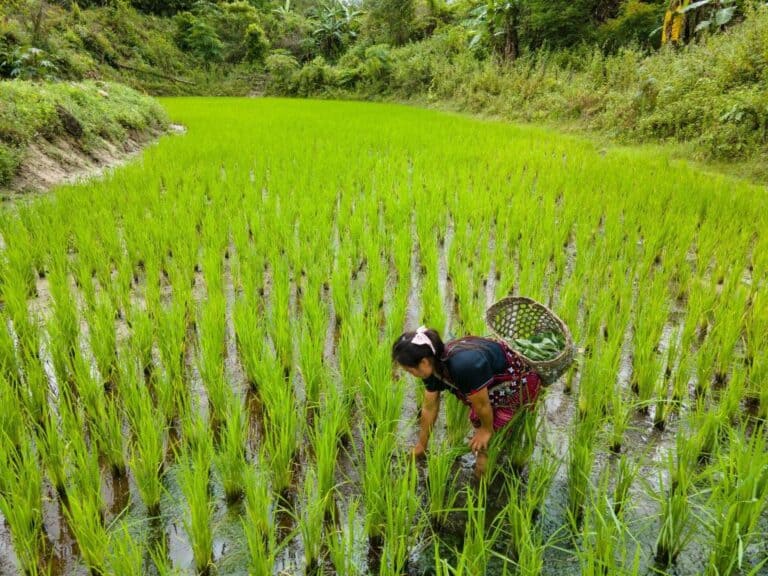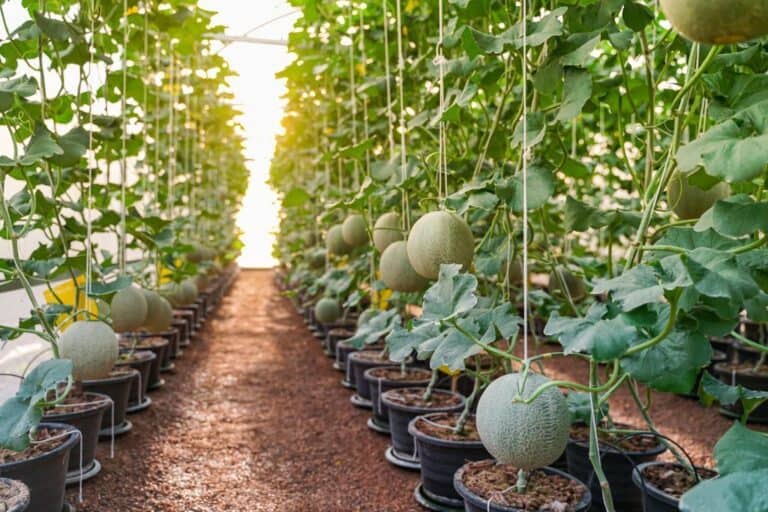Why Are My Cantaloupe Flowering but No Fruit? (Plants Not Producing)

Cantaloupes are one of the world’s most popular fruits, grown for their sweet, orange flesh. Their delicious and creamy flesh is frequently used in fruit salads, and their juice is quite popular worldwide.
Cantaloupes are a warm-weather crop and are planted in late spring or early summer. Cantaloupes grow on a vine, and the fruit is ripe when the skin turns from green to tan or yellow.
Growing cantaloupes at home or in the garden is a rewarding hobby for a lot of people, but they frequently run into challenges. One problem that can occur when growing cantaloupes is that the cantaloupe flowers will bloom but there is no sign of fruit.
This is perplexing to the gardener who is tending the crop, as the plants were heavily fertilized and it seemed most of the requirements for planting cantaloupe were met.
In this article, we will examine in-depth why this issue with cantaloupe flowering but not fruit happened in the first place. In addition, we wil provide everything you need to prevent this occurance in your home garden.
Main Reason Why Cantaloupe Flowering But Not Producing Fruit
When it comes to fruiting plants, cantaloupes are one of several that bloom before they bear fruit. These plants are often simple to cultivate and are easily able to produce fruit.
Occasionally a fluke happens, and your cantaloupe plants won’t produce any fruit, which is still why you planted them in the first place. So what is the main reason for this fruitless problem?
Lack of pollination is most likely to blame for such fruitless problems in squash, muskmelons (cantaloupe), cucumbers, watermelons, and other cucurbit plants.
These plants feature male and female flowers that are isolated from one another and are connected by a short, slender stem (small fruit at the base of the bloom).
However, there are some situations in which bees are unable to successfully pollinate flowers. Your cantaloupe plant will produce flowers, but without pollination, no fruit will grow from its many flowers.
Your Cantaloupe Plants Have Flowers but No Fruit
As summertime nears, many gardeners anticipate the delicious fruits and vegetables their gardens will produce. Sometimes disappointment comes when the plants fail to produce fruit.
This is the story of the cantaloupe plant. In late spring and early summer, this plant puts on a beautiful show with its large, trumpet-shaped flowers. But, as the summer goes on, the plants fail to produce fruit.
There are several reasons why cantaloupes may flowering but not producing fruit.
Pollination:
One possible reason is a lack of pollination. The lack of pollination is often the culprit and can be due to a number of factors, such as inadequate bee populations, improper pollination timing, or unsuitable weather conditions.
One way to increase fruit production is to hand-pollinate the flowers. This can be done by using a small brush or cotton swab to transfer pollen from the male stamen to the female stigma. Pollination should take place early in the morning when flowers are open and moist.
Even if pollination is successful, fruit may not form if temperatures are too hot or too cool or if there is too much rain.
Fertilization:
Another possibility is a lack of fertilization. A healthy garden starts with rich, fertile soil. To ensure your plants get the nutrients they need, you may need to fertilize them regularly.
Fertilizers come in many forms: organic or synthetic, liquid or solid. The type of fertilizer you choose depends on your soil type and the plants you are growing.
In order for fruit to form, a cantaloupe plant needs nitrogen, phosphorus, and potassium. These nutrients can be found in commercial fertilizers or organic matter such as compost or manure.
Temperature:
The temperature may be a factor. Cantaloupes need at least 65 degrees Fahrenheit to grow fruit. The temperature in the greenhouse has been averaging about 55 degrees, which may be why the plants are not fruiting.
Cantaloupes will start flowering but will not produce fruit if the temperatures stay below 60 degrees F for an extended period of time. Cantaloupes need warm temperatures to produce fruit, and if the weather is too cool, they will not flower or fruit.
Light:
Too little light can also prevent cantaloupes from flowering and fruiting. They need at least 6 hours of sunlight per day and temperatures above 70 degrees F to produce fruit. If the plant does not receive enough light, it will not flower and fruit.
So, if you want to get some cantaloupe from your garden, make sure to give your plants plenty of sun exposure.
Soil:
The soil composition can also affect whether or not cantaloupes occur. Many times, we see flowers blooming on a fruit tree and wonder why there isn’t any fruit. The flowers are beautiful, but no fruit is produced. One of the most common reasons is lack of soil nutrition.
If your cantaloupe plant isn’t producing fruit, it’s important to take a look at the soil and make sure that it has the proper nutrients. A lack of nitrogen in the soil can prevent plants from flowering and fruiting.
You can add organic or synthetic fertilizer to the soil to increase the nitrogen level and help promote flowering and fruiting.
Cantaloupe Pollination and Cross Pollination
The Cucurbitaceae family of plants, including cantaloupe, produces male and female flowers on the same plant. The male flowers appear first, and the female blooms follow a few days later.
You may distinguish between male and female cantaloupe flowers by examining the base of the flowers. Female flowers have an unfertilized fruit bulge right below the bud. The fruit develops and matures into cantaloupe after being pollinated or fertilized.
People often think that melons, squash, and cucumbers can cross-pollinate because the plants all grow and flower in similar ways.
This is not the case. Even though they fall into the same cucurbitaceae family, they are different species. Pollen from different species cannot fertilize the female flowers of other species.
Nonetheless, cross-pollination between cultivars of the same species is possible; cultivars should be maintained at least 500 feet apart. The fruits are unaffected by cross-pollination, but the seeds do not look like the parent plants.
INFO![]()
Did you know that you can eat a cantaloupe’s flowers? The petals taste somewhat sweet and are crisp. You can eat them fresh or put them in salads. You can also use them in desserts and drinks. Cantaloupe blossoms have been used in alternative medicine for a long time to treat fever, colds, and other health problems.
Are Bees Necessary for Canteloupe Pollination?
Did you know that honeybees are crucial in the pollination of cantaloupes? In fact, without bees, the cantaloupe industry would suffer a great loss. This is because bees are the only natural pollinators of cantaloupes. Wind and other insects cannot do the job as well as bees.
Bees are attracted to the bright, fragrant flowers of the cantaloupe plant. They fly into the flower to gather nectar and pollen. As they move from flower to flower, they spread pollen. This process of pollination is necessary for fruit production.
TIPS ![]()
If you are growing cantaloupes, it is important to provide a place for honeybees to nest. You can do this by planting bee-friendly plants near your cantaloupe patch. Bee-friendly plants provide food and shelter for honeybees.
Hand-Pollinate Cantaloupe Flowers

One of the challenges of growing cantaloupe is ensuring pollination because so much depends on where you grow the cantaloupe. Honeybees are the primary pollinators of cantaloupes, but if you’re growing them in an urban area or an area without bees, hand pollination is necessary.
Pollinating flowers by hand is a simple process that can be done with a small brush, your finger, or q-tip.
The first step is to identify the male and female flowers. The male flowers have long stamens that extend out from the center of the flower. The female flowers have a small ovary in the center of the flower.
The next step is to collect pollen from a male flower. Simply brush the pollen from the stamen of one flower to the pistil of another. You can also use a small piece of paper or your clothing to transfer pollen. Wind can also be used to transfer pollen between flowers, although it’s not as efficient as hand pollination.
Gently brush the pollen onto the brush or Q-tip. Then, dab it onto the stigma of a female flower. Do this for every female flower on the plant.







